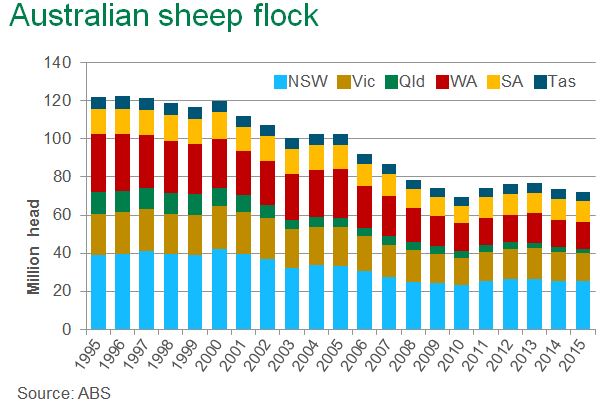Merino breeding ewes decline Australia wide – ABS
Up until 2010, the Australian sheep flock had been contracting at a relatively rapid rate, as many producers shifted focus from wool production to cropping, prime lambs and other enterprises. The fall has stabilised though, and since 2011 averaged around 73 million head, in a range between 70-75 million head (Australian Bureau of Statistics Agricultural Commodities 2014-15).
However, despite the stabilisation, there are still significant movements within the breed and age compositions of the flock.
Nationally, there were 21.6 million marked lambs under one year of age on hand as at 30 June 2015, up 1% year-on-year. The number of pure Merino breeding ewes one year and over (including maiden ewes intended for breeding) on hand was down 12% year-on-year, at 26.8 million head, while other breeding ewes one year and over (including dual purpose, Dohnes and SAMMs) were up 25%, at 12.5 million head. All other sheep (including rams, wethers, hoggets and non-breeding ewes) totalled 9.9 million head at 30 June 2015, down 5% on the previous year.
The rise in lambs younger than one year of age demonstrates turnover rates are increasing, while the significant drop in Merino breeding ewes indicates the transition from wool production to prime lambs continues. The exact same pattern was observed in every state, with the details outlined below.

The total flock in NSW was relatively unchanged in 2015, compared to the previous year, at 26.6 million head. The number of lambs younger than one year of age lifted 1% year-on-year, to 7.9 million head, while Merino breeding ewes one year and over fell 10%, to 10.4 million head. Other breeding ewes one year and over, however, increased 29% on the year prior, to 4.9 million head.
In Victoria, the total number of sheep and lambs in 2015 declined 5%, to 14.6 million head. There were 6% fewer lambs under one year, at 4.3 million head, while Merino breeding ewes (down 22%) and other breeding ewes (up 36%) one year and over totalled 4.5 million head and 3.7 million head, respectively.
The WA flock totalled 14 million head in 2015, a decline of 3% year-on-year. The number of lambs under one year reached 4.4 million head, up 5%, while Merino breeding ewes one year and over were 5% lower than the previous year, at 6.3 million head. Other breeding ewes one year and over declined 9% across the state, to 1.2 million head.
SA was the only state to record an increased flock size from 2014 to 2015, totalling 11.2 million head – 2% higher year-on-year. The supply of lambs under one year of age jumped 7%, to 4 million head. Merino breeding ewes one year and over fell 9%, to 4.1 million head, while other breeding ewes were up 20% on the year prior, to 1.7 million head.
The Tasmanian sheep flock was 21% lower than the previous year, at 2.2 million head, with a 17% drop in lambs under one year of age (624,000 head), a 28% decrease in Merino breeding ewes one year and over (742,000 head), and a 2% decrease in other breeding ewes one year and over (477,000 head)
The total number of sheep and lambs in Queensland in 2015 declined 6% year-on-year, to 2.2 million head. There was a 3% increase in the number of lambs under one year, at 350,000 head. Merino breeding ewes slipped 33%, to 749,000 head, while other breeding ewes more than doubled year-on-year, to 524,000 head.
To view a distribution map of the Australian sheep flock as at 30 June 2015, please click here.



